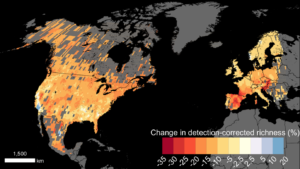Warming temperatures and variable weather are causing local extinctions of important pollinators
 Map of climate related change in bumble bee populations from baseline period (1901-1974) to recent (2001-2014). Credit: Peter Soroye,
Map of climate related change in bumble bee populations from baseline period (1901-1974) to recent (2001-2014). Credit: Peter Soroye,
Tim Newbold, Jeremy Kerr
Bumblebees are important pollinators for many crops that provide vitamins and nutrients in our diet, like tomatoes, squash, blueberries, strawberries, and many others. Bumblebees are native bees that live in the ground and are sensitive to chemicals used in agriculture and variation in weather conditions. A recent study published in Science used a new modeling technique to show that current climate trends are accelerating local extinctions of bumblebees, which will reduce the availability of pollination services to farmers. Instead of just mapping changes in temperature and rainfall to predict bumblebee survival, the researchers also considered the normal thermal range for bumblebees to survive. When temperatures exceed the upper thermal limits of bumblebees, they predict local extinctions. When regions that have historically been too cold for bumblebees get warmer, they predict new populations to colonize. However, overall, the study shows that the current warming of our climate results in far more local extinction than new colonization. In fact, using abundance data from the years 1901 to 2014, they estimated a 46% decline of bumblebees in North America in the last 40 years.
Land use can also influence the survival rate of bumblebees and it is still important to provide chemical-free nesting and food resources throughout rural and urban landscapes. However, despite those efforts, this study also shows the critical importance of slowing global warming for the future survival of beneficial insects like native bees.

